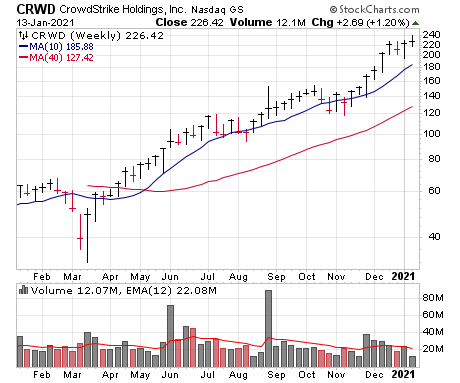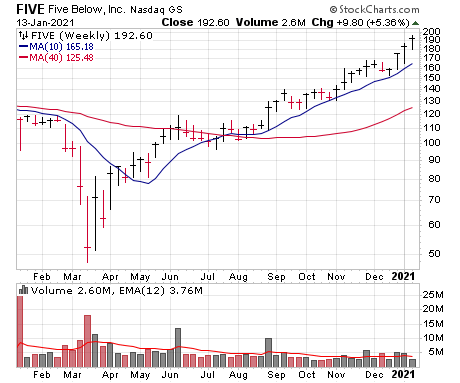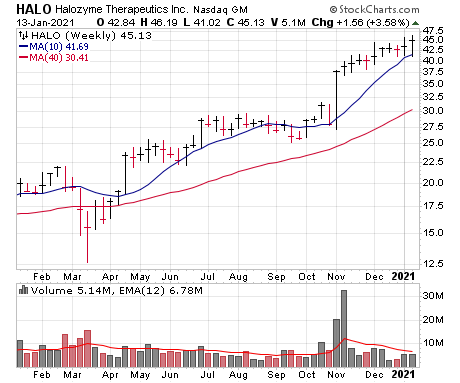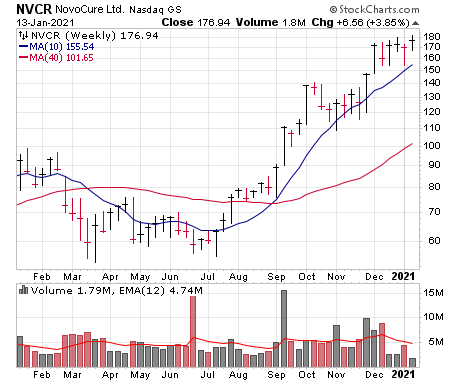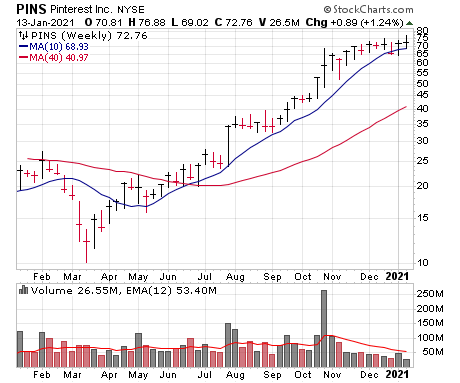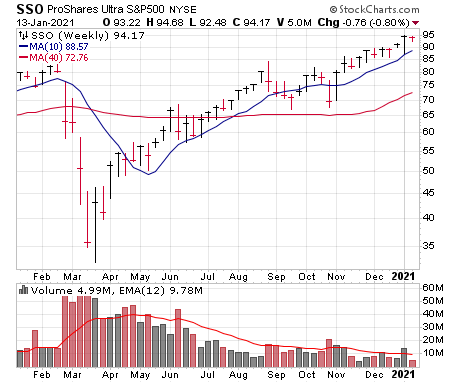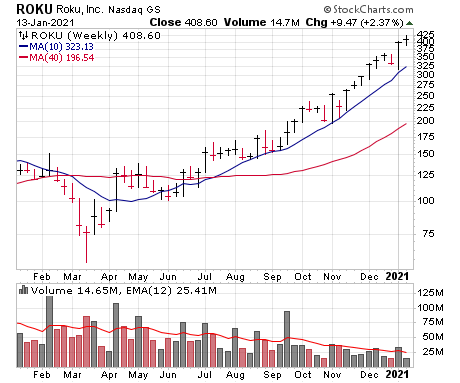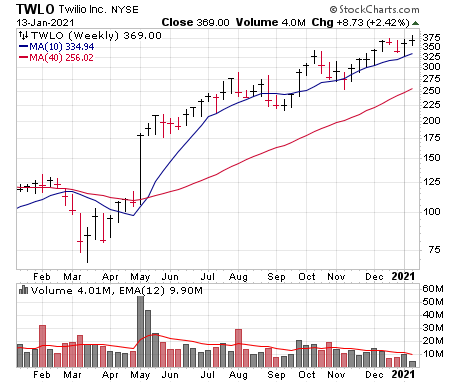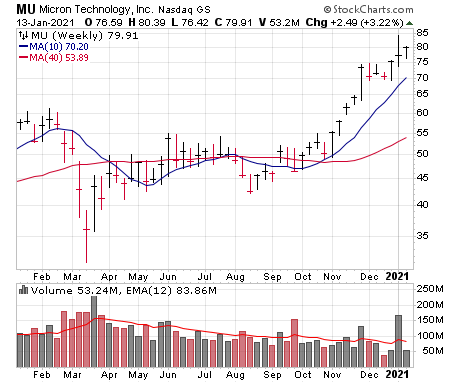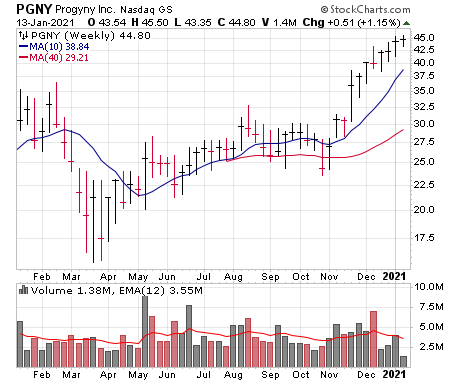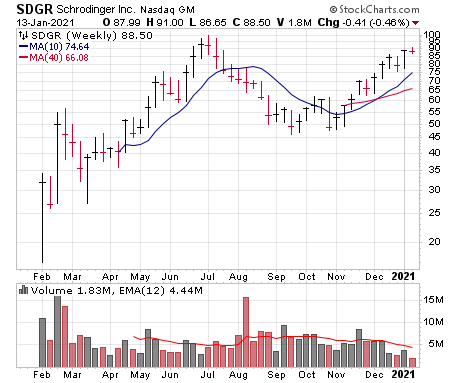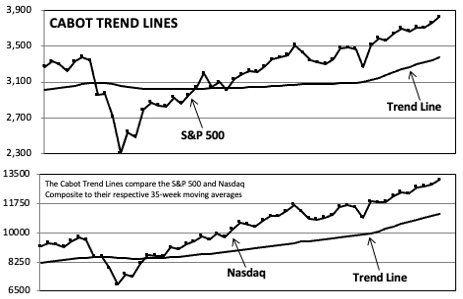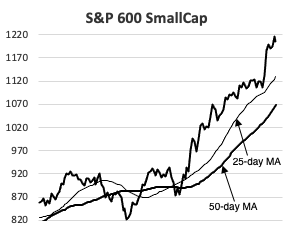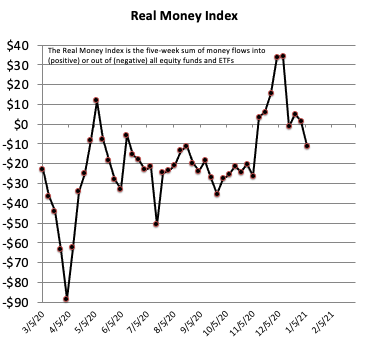The market remains very strong, with the trends of the major indexes and the vast majority of stocks pointed up, both of which keeps us mostly bullish. But really, we’re looking at things mainly on a stock-by-stock basis now; some names are extremely extended and vulnerable to air pockets, while others are just a few weeks into what look like new, sustained advance. With that in mind, we’re actually taking partial profits on one stock today, while averaging up in another — all in all, we’ll still be around 18% in cash.
Elsewhere in tonight’s issue, we write about some of our favorite cookie-cutter stories out there at the moment; we own one great one, but we’d like to have another. And we also review all our stocks, present some new ideas and talk a bit how to handle the speculative, super-hot names in the proper fashion.
Cabot Growth Investor 1463
[premium_html_toc post_id="223469"]
Taking Things on a Stock-by-Stock Basis
We believe one of the main reasons our system has proved durable is that it doesn’t focus on just one or two factors, but incorporates things from different angles. For instance, when selecting stocks, we’re not only looking at charts or solely analyzing a firm’s sales and earnings. Instead, we want it all—a good story, great growth numbers and a bullish chart, taking into account both technicals and fundamentals.
It’s similar with market timing, where we look at both top-down (major indexes) and bottom-up (action of leading stocks) evidence. From a top-down point of view, our trend-following measures are vital—indeed, the major advantage of using trend following is that you’re guaranteed never to miss out on a major upmove, nor sit like a deer in headlights during a sustained downturn.
And we’re happy to report that the intermediate- and longer-term trends of the major indexes are still strongly up; as our founder Carlton Lutts used to say, the most bullish thing a market can do is go up, and that’s certainly the case right now.
However, we’re paying close attention to the bottom-up portion of the analysis these days, as different stocks look to be at different stages of their overall runs. It’s not hard to find stocks that look to be blowing off on the upside, with giant advances last year and a series of gaps higher so far in 2021. Yes, they could go higher, but risk is elevated there. Even on an intermediate-term basis, many stocks are four-plus months into runs that have left them sticking straight up in the air.
On the other hand, there are many growth stocks that just got going from launching pads a couple of months ago, so there’s no reason they can’t keep running. And outside of growth, we’re seeing a ton of longer-term breakouts (sometimes 10-year breakouts!), which obviously bodes well when looking at the big picture.
Thus, it’s a bull market, so we’re remaining heavily invested. But we’re also taking things on a stock-by-stock basis, which means mostly riding your winners higher, but also keeping your feet on the ground while being discerning when it comes to buying.
What To Do Now
That’s the driver of what we’re doing tonight—in the Model Portfolio, we’re going to fill out our position in Halozyme (HALO), adding another half-sized stake, but we’re also going to book partial profits in Roku (ROKU), selling one-third of our shares and holding on tightly to the rest. Our cash position will remain around 17%.
Model Portfolio Update
2021 has started out as whacky and volatile as 2020, with many stocks gyrating at first before racing higher during the past week. We remain bullish, and we’re certainly happy that our stocks continue to act very well, though we’re spending most of our time watching and managing our current positions (a few of which have presented and released Q4 tidbits this week).
However, we’re not content to stand completely still—it’s a strong bull market after all, but the key is looking for halfway decent entry points while keeping your feet on the ground with stocks that have gone vertical. Thus, tonight, we’re making a couple of moves, filling out our position in HALO, which seems to be kicking into gear, but on the flip side, we’re going to take partial profits (selling one-third of our shares) in ROKU, which is very strong but very extended. Our cash position will still be around 17% after the moves.
Current Recommendations
| Stock | No. of Shares | Portfolio Weightings | Price Bought | Date Bought | Price on 1/14/21 | Profit | Rating |
| CrowdStrike | 567 | 6% | 175 | 12/11/20 | 225 | 29% | Buy a Half |
| Five Below (FIVE) | 1277 | 11% | 138 | 9/18/20 | 194 | 41% | Buy |
| Halozyme (HALO) | 2339 | 5% | 41 | 11/27/20 | 47 | 16% | Buy Another Half |
| Novocure (NVCR) | 1,335 | 10% | 142 | 11/6/20 | 179 | 26% | Buy |
| Pinterest (PINS) | 2963 | 10% | 40 | 9/18/20 | 71 | 78% | Buy |
| ProShares Ultra S&P 500 (SSO) | 1,741 | 7% | 60 | 5/29/20 | 93 | 56% | Buy |
| Roku (ROKU) | 901 | 16% | 205 | 8/28/20 | 418 | 104% | Sell 1/3 |
| Twilio (TWLO) | 553 | 9% | 174 | 5/8/20 | 385 | 121% | Buy |
| Uber (UBER) | 3,656 | 9% | 52 | 11/20/20 | 57 | 10% | Buy |
| CASH | $382,540 | 17% |
CrowdStrike (CRWD)—When we first took a stake in CRWD last month, we said that the company has all the makings of an emerging blue chip that will grow rapidly for years and (more importantly for us) become a “core” position in hundreds of funds. So far, that seems to be playing out, with the SolarWinds hack likely to accelerate demand. At an investor event this week, there was lots of technology-riddled chit-chat, but one financial note caught our eye—CrowdStrike’s CEO made it a point to say that as more of its clients add more modules, a lot of that falls right to the bottom line (i.e., huge margins on cross-sells), and they see a lot more of that happening in the future as the business has so much momentum. He also said flat out that the firm isn’t going to necessarily sell out for growth, saying that cash flow is also vital (music to big investors’ ears). As for the stock, it remains strong, though the latest push higher has come on tame volume; that’s not a red flag, but if you want in (whether a new position or to average up), we’d either start small or (preferably) wait for dips. BUY A HALF.
Five Below (FIVE)—The evidence continues to pour in that Five Below is back on track (possibly on an even better track than before), with this week’s Q4 pre-announcement adding conviction to that thesis. The company said the first two months of the holiday quarter (November and December) were great, with 10.1% same-store sales growth, strength seen across categories, and even better, the firm’s upped guidance for the quarter implies that January same-store sales are have accelerated compared to the year-end period. Moreover, the top brass said it plans to grow its store base at a high-teens rate going forward (opening 175 stores this year with another 40-ish remodels), accelerating from last year’s 13% growth track, and believes there could easily be upside to its official 2,500-store target (up from about 1,000 today). The stock has continued its ascent, leaping into the 190s this week on heavy volume, and given that it just had a two-year rest, we think the last few months is likely a kickstart of a new, sustained advance. That said, we’re not leaving our brains at the door, either; FIVE is now 30-plus points above its 50-day line! We’ll stay on Buy, but we advise keeping new positions small and/or looking for dips of a few points at least. BUY.
Halozyme (HALO)—Halozyme is another one of our names to release a bullish 2021 forecast this week: The company expects royalty revenue to double this year, thanks to expanded use of Darzalex (a treatment for multiple myeloma made by J&J and using Halozyme’s Enhanze technology) and Phesgo (for HER2-positive breast cancer, made by Roche), as well as some expected new approvals (Darzalex in Japan, etc.). It also expects three trials to advance into Phase III this year, five more to start Phase I trials, and financially, to buy back $125 million of stock this year. Interestingly, sales and earnings guidance was a bit light of expectations, but (a) it still represented heady growth (40%-plus revenues and 63% earnings growth over 2020), and (b) the guidance doesn’t include any new deals it may ink this year (almost a sure thing that some will, which come with upfront payments). Indeed, analysts see the bottom line up 85% this year, and some unofficial tidbits from a presentation this week (we’re still checking on it) supposedly hinted that uptake of the Enhanze version of Darzalex (as opposed to the “usual” version that delivers doses far slower) is very strong. The stock wobbled on the initial guidance news but is now following through on the upside—we’ll go ahead and fill out our stake, buying another half-sized (5% of the portfolio) position here and using a loss limit in the 37 to 38 area. BUY ANOTHER HALF.
Novocure (NVCR)—Novocure is yet another stock that released preliminary Q4 results in concert with an investor event this week (it presented Tuesday morning at the JP Morgan Healthcare conference): Revenues likely lifted 45% to $144 million ($9 million above estimates), with strong growth seen in every area (up 48% in the U.S., 31% in Germany and up big in Japan and China, too). Active patients totaled 3,411 at year-end, up 17% from a year ago, and the company continues to look for five data readouts from clinical trials using its Optune technology this year (two Phase II and three interim readouts from different Phase III trials). The growth path is clearly on track and with solid sales and earnings growth likely this year, any bullish data could bring in even more big investors. As for the here and now, NVCR has reacted decently to the results, though the last few days of higher prices have seen next to no volume despite the pre-announcement (maybe because there was no 2021 guidance?). We’re not reading too much into that—we’re sitting tight with our shares—but if you’re looking to buy, we’d favor looking for dips of a few points. BUY.
Pinterest (PINS)—PINS has bounced off its 50-day line, which it tagged right at year-end, and actually kissed new high ground yesterday, though it has been pretty sloppy the past couple of days. Odds are against an up-and-away move from here (though in this jubilant environment, anything is possible), but the bounce is another piece of evidence that there are big investors looking to build positions, especially on dips toward support. Fundamentally, nothing has changed, so we’re sticking with our Buy rating, but as with most stocks, ups and downs of a few points are to be expected. BUY.
ProShares Ultra S&P 500 Fund (SSO)—The S&P 500 (and, hence, SSO) is now 10 weeks into its move from its post-election breakout. We wouldn’t say that’s late, but oftentimes these intermediate-term runs off “normal” corrections (not huge declines like last March) will run for three to four months, though of course that’s a ballpark figure. As I’ll expand upon in my webinar next week, I remain very encouraged by the longer-term picture for the market, bolstered in part by a slew of multi-year breakouts in a variety of stocks, sectors and indexes—that’s something you usually see near the start of a major move, not the other way around. Like most things, the near term could be trickier (earnings season is approaching fast), but we’re OK taking a swing at SSO here or on dips if you don’t own any. But if you’re already in, sit tight. BUY.
Roku (ROKU)—ROKU has gone bananas in recent days, lifting out of its early-stage pullback in the last few sessions of 2020 and zooming as high as 420 yesterday and today. Big picture, ROKU is “just” four months into a new advance after a year-long rest, and with connected TV trends accelerating, we think higher prices are likely over time. However, there’s no question the stock is a bit giddy here; shares rallied 100 points in just five days to start the year (!) and are 38% above their 50-day line. We love the story, but the goal is to make (and keep) some profits, so we’ve decided to book partial profits—selling one-third of our shares will not just book some gains, but also allow us to give the rest of our shares plenty of room to digest their recent move whenever they decide to. SELL ONE-THIRD, HOLD THE REST.
Twilio (TWLO)—TWLO is yet another growth stock that pushed nicely higher in late November and most of December, pulled back for a week or two around year-end, and have since rebounded nicely—shares have kissed new high ground a couple of times this week. The firm has been dead quiet on the news front since early November, though some analysts have stepped up with a similar opinion to ours, that the company’s communications platform sits in the heart of the digital movement that’s accelerating through the economy, and that’s likely to produce years of rapid growth. (Twilio itself has a 30%-plus organic growth target for the next few years.) Earnings are likely out in early February, which will obviously be important, but right now the path of least resistance remains up—we’ll stay on Buy, but after the recent 45-point pop, we suggest starting small (half position, etc.) or looking for dips of 10 or 20 points. BUY.
Uber (UBER)—After five weeks of ups and downs (including a knock on the head last Friday after a huge block sale of 38 million shares by Softbank), UBER rallied nicely earlier this week, bolstered by news that it (along with peer Lyft) has talked with Uncle Sam about helping with the vaccine rollout in a couple of different ways (rides to/from vaccine sites, etc.). Beyond the news, though, the recent, controlled rest likely represented big investors accumulating larger positions, and now the next upleg has begun—if all goes well (and the odds favor it will), both the firm’s Rides segment (as the virus fades into memory later this year) and Delivery business (as third-party delivery of groceries, take-out and even prescriptions become mainstream) should surge in the quarters to come. The stock did get hit today, but while we’re never complacent, there’s no question the trend is strongly up. Hold on if you own some, and if you don’t, we’re OK buying some here or on any weakness. BUY.
Watch List
- Bill.com (BILL 128): BILL remains squirrelly, which is our biggest beef, but we love the story, the growing sponsorship and the orderly pullback of the past three weeks.
- Farfetch (FTCH 60): FTCH is now three weeks into a very reasonable rest as the 50-day line (now near 55) catches up. We could start a position in this new leader on a shakeout of a few points.
- Floor & Décor (FND 105): FND is our favorite cookie-cutter story outside of Five Below; shares have popped to new highs on light volume lately. See our writeup later in this issue.
- Teladoc (TDOC 226): TDOC continues to shape up after a five-plus month rest. We’d like to see a clear, decisive show of strength (maybe on earnings?) to indicate the major uptrend has resumed.
Other Stocks of Interest
Micron Technology (MU 81)—Chip stocks are always tricky to handle, and when it comes to a name like Micron, which is a leader in solid state memory, that goes double—in many ways MU is more of a cyclical stock than a growth stock. But when the trend turns up (for the stock and for business), it usually persists for many months (if not years), and it looks like that’s recently occurred. The company gets about 70% of its revenue from DRAM products (used in electronics, memory, and graphics cards), with nearly all the rest coming from NAND (used in flash drives, SD cards, etc.); all in, networking- and mobile-related revenue makes up more than two-thirds of the total. Beyond the product specifics, though, are industry factors—oversupply and softening demand crushed sales and earnings starting in 2019 (earnings fell from $12 per share in fiscal 2018 to $2.83 last year), but things have begun to turn around: In the just-reported quarter (January 7), management said the industry is likely to see DRAM supply lag demand in 2021 (i.e., higher prices are coming), and the firm’s own cost reduction efforts are likely to help the bottom line, too. All told, the fiscal first quarter saw sales up 12%, earnings up 63% (78 cents per share and 30 cents above estimates!) and analysts are tripping over themselves to up their forecasts (now see earnings of $4 per share this year, up from a $3 guesstimate three months ago). But, as mentioned above, more important than the next quarter or two is the major trend—as global economies ramp up, demand could easily outpace expectations, and it looks like earnings have begun their next multi-quarter (or multi-year) upcycle. And the stock is backing that up—MU built a 28-month launching pad from mid 2018 through October of last year, decisively broke out on the upside after the election and has kited higher since. Any pullback of a few points will probably be buyable.
Progyny (PGNY 45)—Progyny is a bit thinly traded for us (for now), but it has a story we think can go far, so if more institutions take a liking to it we could look for an entry point. The company’s story is all about babies, in particular helping those who have trouble conceiving, a growing problem as couples are generally having kids later in life (fertility decreases as time passes, generally speaking). Current insurance and benefits solutions aren’t working well, with not only tough choices (financial and otherwise) for aspiring parents but also big costs (absenteeism, stress leading to a lack of productivity) for employers, too. Enter Progyny, which has a unique plan design that features a network of 800-plus fertility experts, all-inclusive treatment bundles that users can choose from, pharmacy offerings and personalized, unlimited support services. Those taking advantage of this plan have been shown to have far greater and happier outcomes, including improved pregnancy rates, fewer miscarriages and a far lower rate of multiples (twins, triplets, etc.). Basically, Progyny has found a niche and built a network and pharmacy operation to exploit it, and big firms are signing up in droves—135 employers are now customers (including big ones like Microsoft, Cerner, PayPal, Google, Hershey, Uber, Genentech, etc.), up 61% from a year ago. Plus, retention rates are near 100% and the company believes it’s just scratching the surface of its potential. And the financials support that view—after a brief virus-induced slowdown, sales ramped up 62% in Q3 and analysts see the top line growing north of 50% in 2021, while earnings triple and cash flow surges. The stock broke free from a nine-month post-IPO base in November and has glided higher since. Competition will be the question, as it’s possible some big managed care outfits could try to mimic these offerings, but there’s no question Progyny is the leader and is quickly capturing the market, which should lead to rapid, reliable growth for many years.
Schrodinger (SDGR 93)—Developing new drugs is extremely costly and time consuming, and much of that comes way before something enters clinical trials—drug “designers” have to balance a ton of factors (potency, interactions with other drugs, toxicity, etc.), which is a big reason why two-thirds of all programs never even develop into an investigational drug. Schrodinger is improving that percentage with a powerful platform that combines physics with machine learning and AI to better enable ultra-large-scale research of various molecules that could become candidates for a drug; indeed, the firm claims its software helps analyze and test far more molecules that end up with fewer issues than the standard process. While it’ll never be a household name, Schrodinger is well known in the industry, as the top 20 pharmaceutical firms are customers (they have been for years), and it’s inked some intriguing partnerships, too—in November, the firm announced a discovery collaboration with Squibb that brought in $55 million upfront and the potential for $2.7 billion (!) of milestone and royalty payments down the road, plus it also has smaller deals with Takeda and Thermo Fisher. (For small clients, Schrodinger often gets a chunk of equity; a couple of those clients have since gone public.) And the firm also has its own drug discovery program, which could add value down the road. Still, right now, it’s mostly about the platform, and after a little slowdown last year, growth is picking up again—sales rose 29% in Q3 and are expected to lift 57% in 2021, while earnings were in the black last quarter and should mostly remain positive going ahead. The valuation is huge ($6.2 billion market cap on $100 million run rate of revenue), but we’re intrigued that big investors don’t mind (293 funds owned shares at year-end, up from 193 nine months before), as SDGR has been rounding out a deep base. A couple of weeks of tight trading could present an entry point.
Always Keep an Eye Open for Cookie-Cutter Stories
When most think of growth stocks, they think of some sort of new, revolutionary technology or medical product—and, indeed, those are among our favorite names to look for and have represented many of our big winners over the years.
But one theme that many tend to overlook are cookie-cutter situations—i.e., retail firms that are able to post steady growth mostly by opening up new stores or restaurants over time. (The bias against these names is even more pronounced these days as in-store shopping is being replaced by e-commerce.) Even so, cookie-cutter stories are scattered throughout the annals of top-performing stocks in market history (think Home Depot, Costco or McDonald’s) because, while they’ll never have the triple-digit growth profile of a hot, new technology name, they usually produce very reliable results, which means big investors are comfortable building large positions.
We already have one cookie-cutter story in the Model Portfolio: Five Below (FIVE) has a long runway of growth (it will likely be able to grow its store base 2.5x to 3x at least from here) but also best-in-class store economics (payback of new openings in a year or so). It continues to act great, and while we’re half-expecting a near-term pothole after the recent run, the stock just got going from a two-year dead period in September, so we certainly don’t think the run is over.
We wouldn’t mind having another cookie-cutter story in the portfolio, so we’re keeping our eyes open for possibilities. Probably our top candidate right now is Floor & Décor (FND), which we wrote up a month ago and is on our watch list—not only is it set to grow its store count by 20% annually (it believes it has room for 400 locations in the U.S., up from 130 or so today), but it’s also a play on the new housing/construction boom that’s in effect. Same-store sales have also been very strong in recent quarters.
We’re also still keeping an eye on Wingstop (WING), which we owned for a while last year (exited around breakeven). At last check, management thought there was room for a whopping 6,000 locations worldwide (!) compared to 1,479 at the end of September, with plans for double-digit new store growth annually. Business went nuts last year, but the stock has been etching a new launching pad as investors wait to see whether a return to economic normalcy will crimp growth. Beyond the next few months, though, this firm is aiming to be a top 10 global restaurant brand.
Then there’s Ollie’s Bargain Outlet (OLLI), which can grow its warehouse count at double-digit rates for many years and is similar to WING in the sense that it’s been building a base for a few months as investors assess the post-pandemic growth rate. And Shake Shack (SHAK) is a restaurant with an OK history (profits never were consistent) that’s storming back from pandemic-induced shrinkage last year; just this week it said it’s aiming for a 45% hike in its company-operated restaurant count during the next two years, helping shares rally nicely.
We’re not making any moves today, but as we wrote above, we’d like to own another steady, reliable cookie-cutter grower if the opportunity arises.
Lottery Tickets are Fine—but Treat them as Such
In the real world, we all know about the handful of items that, in a vacuum, aren’t good for us—if you smoke too much, or drink a lot every day, or even are loose with money (gambling huge amounts), it’s not likely to end well. But most of us also know that, taken in moderation, such “bad” things can be enjoyable and not overly harmful. (Get ready for a fight if you try to pry away my occasional cigar and Manhattan.)
It’s a similar story with stock selection, where the “sin” is throwing money at a super strong (but super extended) stock because it has a sexy story ... but little in the way of what really counts (sales, earnings, sponsorship, reliability, liquidity, etc.). We call these types of stocks lottery tickets for obvious reasons—they can occasionally hit big, but many times, they end up costing you money.
As in real life, there’s nothing wrong with a walk on the wild side—if you want to speculate in one of these super-hot lottery tickets, go for it, but keep positions (very) small and make sure to have your hand on the rip cord for when the sellers show up. We’ve heard from way too many people asking us about one of these fliers months after the top, wondering what to do after the name has crashed 60% or more.
Most of all, keep in mind that, over time, the big money comes in the big swing: By owning a fresh, institutional-quality leader for many months or years as it takes off and (ideally) changes the way millions of people work and live. That’s where the real profits come from and where you want all (or nearly all) of your focus.
Cabot Market Timing Indicators
There’s no doubt that the environment is fairly bubbly, especially as some names head into climactic runs. However, the trends of the market and leading stocks remain strong, keeping us mostly bullish; the trick is to take things on a stock-by-stock basis and recognizing what names are extended and which ones are early in their runs.
Cabot Trend Lines: Bullish
Our Cabot Trend Lines remain in the stratosphere, with the S&P (by more than 13%) and Nasdaq (by nearly 19%) standing miles above their respective 35-week moving averages. At some point, these percentages will come down to earth (via both the market coming down and the moving averages climbing), but the point here is that even a good-sized retreat isn’t going to change the longer-term trend—i.e., the bull market has longer to run.
Cabot Tides: Bullish
Our Cabot Tides are also in great shape—all five major indexes remain well above their lower (50-day), rising moving averages. The strongest of the bunch is still the S&P 600 SmallCap (shown here), which is acting very well after its multi-year breakout in November. Yes, things are hot and heavy, but with the intermediate- and longer-term trend pointed up, you should stick to a mostly bullish stance.
Cabot Real Money Index: Neutral
Our Real Money Index has actually cooled off a bit in recent weeks, as money has started to come back out of the market. The five-week sum (shown here) is still affected by end-of-year outflows (a seasonal tendency), so we’ll be watching what happens in the weeks to come. At this point, it looks like the bad headlines of late have unnerved some investors.
Charts courtesy of StockCharts.com
The next Cabot Growth Investor issue will be published on January 28, 2021.
Cabot Wealth Network
Publishing independent investment advice since 1970.
President & CEO: Ed Coburn
Chairman & Chief Investment Strategist: Timothy Lutts
176 North Street, PO Box 2049, Salem, MA 01970 USA
800-326-8826 | support@cabotwealth.com | CabotWealth.com
Copyright © 2021. All rights reserved. Copying or electronic transmission of this information is a violation of copyright law. For the protection of our subscribers, copyright violations will result in immediate termination of all subscriptions without refund. No Conflicts: Cabot Wealth Network exists to serve you, our readers. We derive 100% of our revenue, or close to it, from selling subscriptions to its publications. Neither Cabot Wealth Network nor our employees are compensated in any way by the companies whose stocks we recommend or providers of associated financial services. Disclaimer: Sources of information are believed to be reliable but they are not guaranteed to be complete or error-free. Recommendations, opinions or suggestions are given with the understanding that subscribers acting on information assume all risks involved. Buy/Sell Recommendations: All recommendations are made in regular issues or email alerts or updates and posted on the private subscriber web page. Performance: The performance of this portfolio is determined using the midpoint of the high and low on the day following the recommendation. Cabot’s policy is to sell any stock that shows a loss of 20% in a bull market or 15% in a bear market from the original purchase price, calculated using the current closing price. Subscribers should apply loss limits based on their own personal purchase prices.
